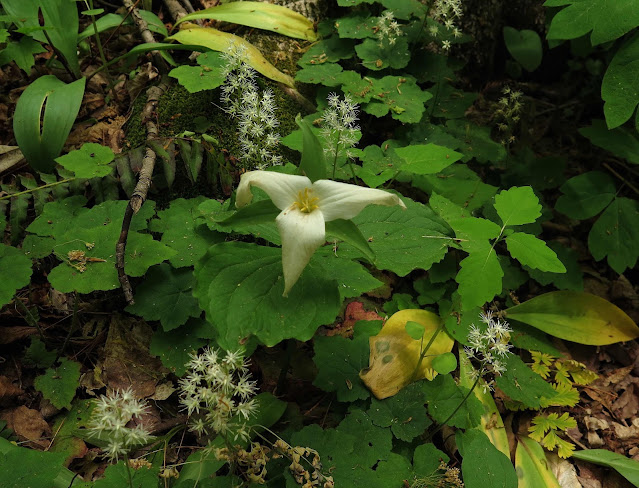May 20 was bright overcast and cool, perfect conditions for exploring the Mount Tom State Forest, a 1700-acre preserve in Washington County, very close to New York's border with Vermont. This field trip, offered by the New York Flora Association and led by the New York Natural Heritage Program's chief botanist, Richard Ring, was attended by a happy group of adventurers, eager to see what plants might be flourishing in this rich woods. With the tree canopy only recently closed over by spring's new leaves, the very air was luminous, lit by a soft green light as we eagerly set off into the forest.
Our trip leader, Rich Ring (red jacket), confers with fellow plant enthusiast Tom Phillips, while Rich's Natural Heritage Program colleague, Elizabeth Spencer, prepares to document all our botanical finds as we explore this forested and mountainous terrain. Two of our fellow attendees (center) are already busy exploring a boulder's botanical offerings.
Much of our trail passed between gigantic cliffs and rocky ledges, whose mineral content contributes to a calcareous habitat for many lime-loving plants that thrive on the forest floor. And the "bryo-philes" among us found much to attract their interest among the cliffs' myriad cracks and crannies, home to many different species of mosses, liverworts, and lichens.
A recent regional heatwave brought many spring wildflowers into bloom much earlier than usual, so we considered ourselves lucky to find a few still-flourishing blooms on the many Large-flowered White Trilliums (Trillium grandiflorum) that abound in this rich woods.
Some Large-flowered White Trilliums were obviously fading, while many Foamflowers (Tiarella stolonifera) still flourished with sparkler-like inflorescences. The yellowing leaves in this photo belong to our native wild leek, called Ramps (Allium tricoccum), which loses its leaves before it even starts to flower.
As our trail began to pass through a hemlock-dominated section, I mentioned to one of my companions that a hemlock woods was a good place to look for Painted Trillium (Trillium undulatum), one of our very few native wildflowers that can tolerate the tannin-saturated soil under hemlocks. And guess what? Et voila!!!
I look forward to reading Elizabeth Spencer's plant list to remind me of all the wildflowers we found but which I did not manage to photograph, while trying to keep up with our more able-bodied companions (huff puff!). I did manage to snap a few, including this puffy white inflorescence atop a White Baneberry plant (Actaea pachypoda), distinguishable from that of Red Baneberry by the stubbier pedicels and more oval (rather than spherical) shape of the bloom.
Lots of violets of several colors flourish here, including some called Downy Yellow Violet (Viola pubescens), a stemmed species frequently found in calcareous habitats like this.
Hundreds of tiny white basal-leaved violets lined the trail and confounded even the professional botanists among us as to which species of small white violet they might be. Somebody's cellphone app claimed they were Viola macloskeyi. But wait! Isn't that a species native only to the northwestern U.S.? Or has violet-expert Harvey Ballard's new monograph on northeastern violets re-assigned one of our eastern early white violets to this taxon? Aaargh!!
At least none of us had any doubts as to what this lovely stemmed violet's name was. The yellow-throated, pure-white face and purple petal-backs are distinguishing traits of no other violet but Canada Violet (Viola canadensis). As is the calcareous habitat. And the neighboring Maidenhair Fern (Adiantum pedatum) is often found accompanying Canada Violets, since both are calciphiles.
Is Blue Cohosh a calciphile? And which Blue Cohosh is this, surrounded by Christmas Fern and some species of wild currant? I can distinguish the purple-flowered Early Blue Cohosh (Caulophyllum giganteum) from the later-blooming yellowish-flowered Blue Cohosh (C. thalictroides) when they are new, but by this late in spring, they both look alike to me. I know that I do find both species in a limestone-underlaid woods in Saratoga Springs, but I do not know if that is exclusively their habitat.
But I have found this next fern, called Goldie's Fern (Dryopteris goldieana) only in lime-rich forests. The last time I saw it (years ago!) was near marble quarries in Vermont, but I recognized it here right away, first by its larger-than-most-ferns size, and also by how its green color seems to fade to nearly gold by the tips of its pinnules.
(My friend Sue Pierce's photo of Goldie's Fern better captured the golden glow of this lovely fern. Her photo also included a few fronds of Glade Fern, another fern known to prefer such a lime-rich habitat.)
Photo by Sue Pierce
Glade Fern (Homalosorus pycnocarpos) -- formerly known as Diplazium pycnocarpon -- is a species that I have seen before only near marble or limestone. Its upright posture with closely-held narrowish fronds are distinctive, as are the slender shiny-green uncut pinnae, which tend at the apex to curl at the tips like a fiddlehead. In many ways, ferns all kind of look alike at first, while close examination reveals all the ways one fern can be told from another.
Time for lunch! Some happy hikers find the best seats in the house. My friend Sue Pierce caught hungry me putting my camera away so that I could grab my sandwich.
Photo by Sue Pierce
Those "mossers" over there must have missed the dinner bell (or, more likely ignored it for interrupting their fascinated examinations). But they'd better take some sustenance for the challenges about to ensue.
Yep. Now we're heading up. And up and up and up. Sometimes on my hands and knees, in fact. Do you see that narrow trail on the left, leading up and around this crag? That's where we're going next. And that's where my photographing ends, since I needed my hands to grasp tree trunks to haul myself up steep slopes. But I made it! What a trip! Lots of plants, lots of fun, lots of great friendly and knowledgeable folks. And only a few sore muscles the next day.

















Sounds like a great outing!
ReplyDelete